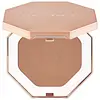Fenty Beauty Sun Stalk'r Instant Warmth Bronzer Versus Physician's Formula Magic Mosaic Multi-Colored Custom Bronzer Warm Beige
What's inside
What's inside
 Key Ingredients
Key Ingredients

 Benefits
Benefits

 Concerns
Concerns

 Ingredients Side-by-side
Ingredients Side-by-side

Synthetic Fluorphlogopite
Talc
AbrasiveMagnesium Myristate
Hdi/Trimethylol Hexyllactone Crosspolymer
Mica
Cosmetic ColorantPolymethyl Methacrylate
Dimethicone
EmollientIsodecyl Neopentanoate
EmollientSilica
AbrasiveTrimethylsiloxysilicate
EmollientTriethoxycaprylylsilane
Polypropylsilsesquioxane
Diisostearyl Malate
EmollientCaprylyl Glycol
EmollientDimethiconol
EmollientPhenoxyethanol
PreservativeOctyldodecyl Stearoyl Stearate
EmollientHexylene Glycol
EmulsifyingLauroyl Lysine
Skin ConditioningTocopheryl Acetate
AntioxidantTocopherol
AntioxidantWater
Skin ConditioningMaltodextrin
AbsorbentCarica Papaya Fruit Extract
Skin ConditioningMangifera Indica Fruit Extract
Skin ConditioningCalcium Sodium Borosilicate
Calcium Aluminum Borosilicate
Xanthan Gum
EmulsifyingEthylhexylglycerin
Skin ConditioningSorbic Acid
PreservativeTin Oxide
AbrasiveIron Oxides
CI 77891
Cosmetic ColorantCI 77742
Cosmetic ColorantSynthetic Fluorphlogopite, Talc, Magnesium Myristate, Hdi/Trimethylol Hexyllactone Crosspolymer, Mica, Polymethyl Methacrylate, Dimethicone, Isodecyl Neopentanoate, Silica, Trimethylsiloxysilicate, Triethoxycaprylylsilane, Polypropylsilsesquioxane, Diisostearyl Malate, Caprylyl Glycol, Dimethiconol, Phenoxyethanol, Octyldodecyl Stearoyl Stearate, Hexylene Glycol, Lauroyl Lysine, Tocopheryl Acetate, Tocopherol, Water, Maltodextrin, Carica Papaya Fruit Extract, Mangifera Indica Fruit Extract, Calcium Sodium Borosilicate, Calcium Aluminum Borosilicate, Xanthan Gum, Ethylhexylglycerin, Sorbic Acid, Tin Oxide, Iron Oxides, CI 77891, CI 77742
Ingredients Explained
These ingredients are found in both products.
Ingredients higher up in an ingredient list are typically present in a larger amount.
Dimethicone is a type of synthetic silicone created from natural materials such as quartz.
What it does:
Dimethicone comes in different viscosities:
Depending on the viscosity, dimethicone has different properties.
Ingredients lists don't always show which type is used, so we recommend reaching out to the brand if you have questions about the viscosity.
This ingredient is unlikely to cause irritation because it does not get absorbed into skin. However, people with silicone allergies should be careful about using this ingredient.
Note: Dimethicone may contribute to pilling. This is because it is not oil or water soluble, so pilling may occur when layered with products. When mixed with heavy oils in a formula, the outcome is also quite greasy.
Learn more about DimethiconeMica is a naturally occurring mineral used to add shimmer and color in cosmetics. It can also help improve the texture of a product or give it an opaque, white/silver color.
Serecite is the name for very fine but ragged grains of mica.
This ingredient is often coated with metal oxides like titanium dioxide. Trace amounts of heavy metals may be found in mica, but these metals are not harmful in our personal products.
Mica has been used since prehistoric times throughout the world. Ancient Egyptian, Indian, Greek, Roman, Aztec, and Chinese civilizations have used mica.
Learn more about MicaOctyldodecyl Stearoyl Stearate is created from stearic acid.
It is an emollient and thickens the lipid (oil) portion of a product. Due to its emollient properties, it may not be fungal-acne safe.
Sorbic Acid is a preservative. It is the most commonly used food preservative in the world.
Sorbic Acid is a natural antibiotic and highly effective at preventing the growth of fungus. It is less effective against bacteria.
Potassium Sorbate, another commonly-used preservative, is the potassium salt of Sorbic Acid.
Sorbic Acid may worsen eczema. We recommend speaking with a professional if you have any concerns.
Potassium sorbate and sorbic acid can be found in baked goods, cheeses, dried meats, dried fruit, ice cream, pickles, wine, yogurt, and more.
Learn more about Sorbic AcidTalc is a clay mineral. It helps absorb moisture and improve the texture of products. Like other types of clay, Talc can have a slight exfoliating effect on skin. Talc can be added to increase the volume of products.
Some Baby powders are made by combining talc with corn starch. The word "talc" comes from Latin and originates from Arabic. Talc is a mineral commonly found throughout the world.
If you have any concerns about using talc, we recommend checking out the FDA's official page.
Learn more about TalcTocopheryl Acetate is AKA Vitamin E. It is an antioxidant and protects your skin from free radicals. Free radicals damage the skin by breaking down collagen.
One study found using Tocopheryl Acetate with Vitamin C decreased the number of sunburned cells.
Tocopheryl Acetate is commonly found in both skincare and dietary supplements.
Learn more about Tocopheryl AcetateThis ingredient is a combination of red, black, and yellow iron oxide pigments. This combination of colors is usually found in foundation, because it results in a "skin" color.